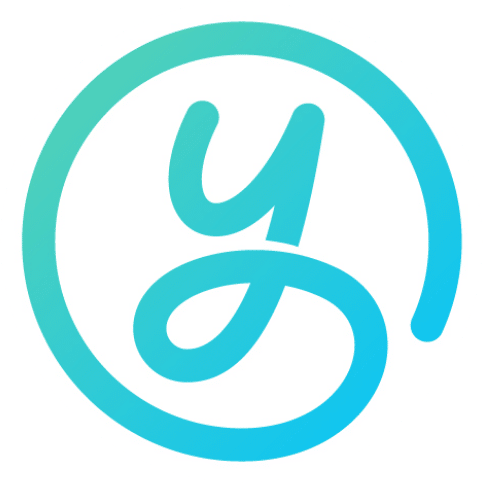At school, you’ve written extensive academic essays, evaluated classical literature, and enhanced your vocabulary.
But you’ve never learned—and intentionally practiced—how to craft compelling stories.
The Narrative Communication Approach™ is an essential communication approach that works in the real world, especially in your applications to universities, scholarships, and jobs.
You might be asking: “Why are communication skills important?”
Well, you can spend all the time in the world on exceptional grades, extracurriculars, and personal growth—but if you can’t communicate your efforts effectively to your audience, what’s the point of all that effort?
Why else would top-tier university programs have terms like ‘exemplary writing ability’, ‘clear communication’, and ‘structured writing’ on their evaluation criteria?
Not to mention that employers pay more attention to applicants that show exceptional communication skills on their resume and during the interview process.
Employers cite communication as a huge skills gap with students. Our coaches see the same:
- Students struggling to communicate in essays with the limited word count
- Students who are unsure what topic to write about and how to present it correctly
- Students who are confused about how to create an ‘emotional’ story that connects with the reader
- Students writing essays that don’t flow and are unclear to the reader
After more than 10 years doing is, it’s very clear to us:
Communication is the most overlooked link to post-secondary success.
That’s why our coaches spend significant time improving students’ communication skills through our Narrative Communication Approach™.
This technique has been vetted and refined from 10+ years of experience and 1,000+ students successfully admitted into their top-choice post-secondary programs.
The Narrative Communication Approach™ is designed for personal questions, like this one from Queen’s Commerce: “Question: Tell us something about you (background, an interest, a talent, etc.) that is an integral part of your identity, and why.” Learn more about personal questions and how to answer them in our Interview Skills Prep Guide.
Refer to our Deductive Communication Approach™ Skills Guide if your application asks a problem-based question like in Question 2 from McMaster Health Sciences’ 2021 Supplementary Application.
IMPORTANT: While most students use the Narrative Approach for Business/Arts app essays and personal interview questions, and the Deductive Approach for STEM app essays and problem-based interview questions, each of these approaches works for BOTH types of questions. If you are unsure which communication approach to use, connect with a coach for support.
If you’re not already working with a coach, find a match in just a few minutes here.
Table of Contents:
- The Basics: What is the Narrative Communication Approach™?; Why is it important?; and More.
- The Framework: The 5 essential elements of creating a standout essay; Do’s and don’ts for writing; and More.
- The Process: How to brainstorm ideas; How to set up and edit your essay; and More.
The Basics: Narrative Communication Skills.
Communication Skills: What is the Narrative Communication Approach™?
The Narrative Communication Approach™ is a framework that helps you tell stories in a logical manner, while connecting emotionally with the reader.
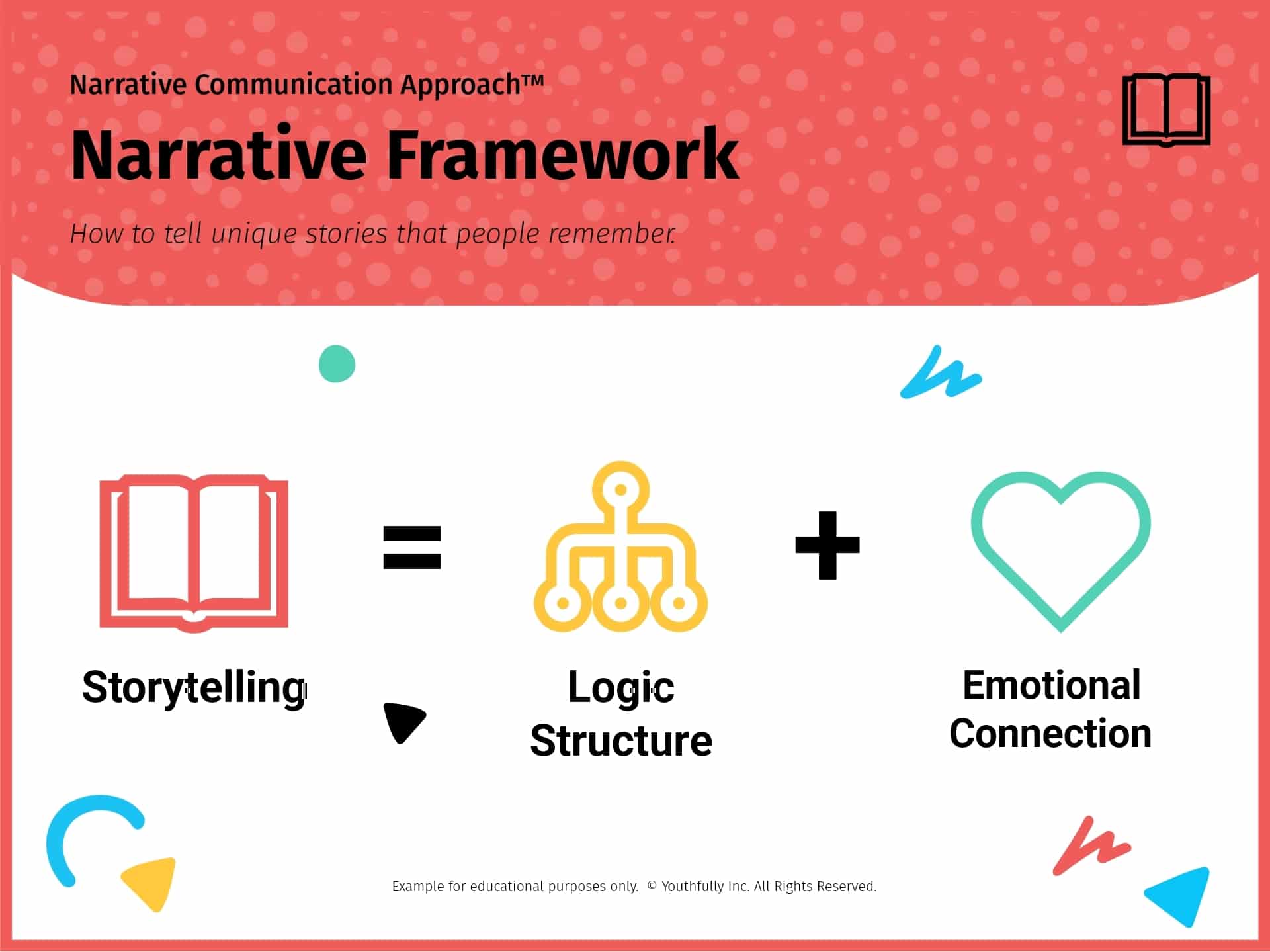
Understanding this approach will not only help increase your chances of admissions, but it will also make you a better communicator in other areas of your life when you’re:
- Telling stories to friends and family
- Creating content for social media
- Explaining an issue over the phone to a customer service representative
- Completing essays and assignments for teachers
Communication Skills: Why does the Narrative Communication Approach™ Work?
Storytelling is important for your audience because it keeps them interested and makes them want to learn more about you.
Think about a subject in school that you find really difficult. You can get a bunch of facts thrown at you by your teacher, but they don’t really mean anything unless you relate them to something.
Research shows that stories are 22x more memorable than simply reciting a bunch of facts because they actually make us use our brains differently. Emotional connection, imagery, and narrative make the material easier to learn and remember. How cool is that?!
For example, say you’re learning about the Battle of Thermopylae between the Greeks and Persians. You’re reading about the names of the main players, the battle formations, and the outcome.
But, once you finish reading, you immediately forget everything (that’s always so frustrating!). Then, you turn on the movie 300 (2007). Even though it isn’t completely accurate, it’s the character portrayals, the plot points and details, and the storytelling, that makes you remember the general course of events and keeps you invested in the characters.
Think of your essay the SAME WAY.
Admissions committees will forget everything you’ve said unless you use an engaging story to help them remember it.
Using storytelling in your essay will help you:
- Convey the important elements about you from your Student Identity Blueprint™ (don’t have one of these yet? Connect with a coach to get one and check out this free resource to learn why it’s so important!)
- Build a lasting emotional connection with your audience
- Show that you’re well-rounded and passionate about the field of study you’re applying to
- Communicate in a way that’s clear, compelling, and concise
It is also important to remember that the people reading your essays are in the same field (i.e. business, arts, etc.) so you need to tailor your communication approach to that specific field. Keep reading to learn how!
You Might Also Like
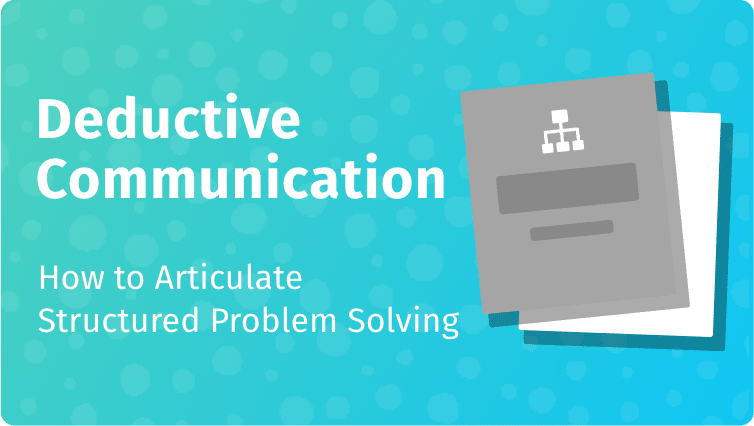
Skills Training
Deductive Communication: How to Improve Your Communication Skills With Structured Problem Solving
What’s the #1 thing you need to do if you’re applying to the most competitive university programs in Canada and… Read more
The Framework: How to Build Narrative Communication Skills.
All stories, including all movies, use a 3-5 act structure (also known as a narrative arc) to engage the audience.
Our Narrative Communication Approach™ is the same in that it follows a similar storytelling structure.
There are five basic components:
- Hook: The story starts with a curiosity-inducing event or captivating experience that makes the audience want to keep watching/reading.
- Context: The setting is established and we get the basic information: Who, What, When, Where, and Why?
- Catalyst: A specific event or problem arises, causing challenges for the main characters. The climax of the story is usually within the Catalyst.
- Outcome: This section showcases the result of the character’s actions and the impact on themselves and others.
- Reflection: This is the moral of the story, where the protagonist reveals what they have learned and how it has impacted their life going forward.
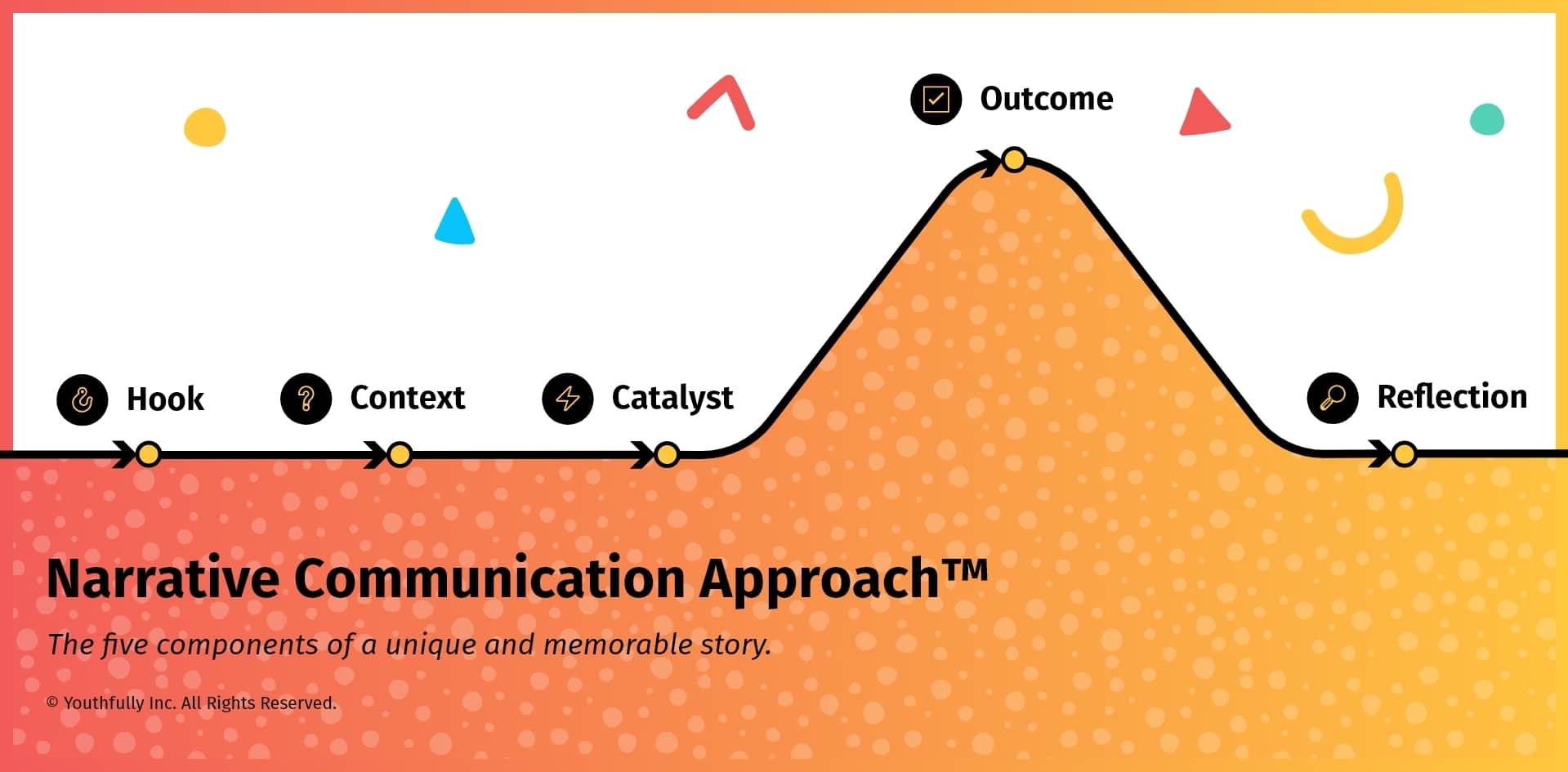
We use this communication structure in ALL of our suggested essay templates and examples, so it’s important that you understand it before using those resources.
If you haven’t already, connect with a coach to start working on your template and get some helpful essay examples.
Let’s take a closer look at each of these components and how you can apply them to your essays and everyday life.
Improve Your Communication Skills – Hook
Put simply, your story’s Hook will:
- Capture the reader’s attention
- Introduce the topics/themes in the story
- Provide a bit of background of what’s to come
- Make an emotional connection with the audience from the beginning
REMEMBER: The Hook section isn’t meant to be a summary of your entire essay. It is simply used to provide a PREVIEW and draw the audience in.
Not all stories use a Hook (and most would make perfect sense without it).
COACH’S TIP: Write the Hook last and only use it if you have the character/word space. Limit it to 1-2 sentences as a general rule of thumb. If you have the space in your essay, you can use it, but don’t feel like you have to.
Let’s use the movie The Fast and the Furious (2001) as an example. In this movie, the Hook is the opening scene, where we see a deserted highway with three modified Honda Civics zooming into the shot towards a transport truck.
With a series of exciting driving techniques and high speed twists and turns, the cars steal the truck’s cargo and escape into the night. This sets the stage for the edge-of-your-seat, thriller of a movie that’s to come. While this scene is awesome, the movie would also make complete sense without it.

Communication Skills Examples – Hook
Here is an example of a Hook from a Business/Arts application to Queen’s Commerce.
REMEMBER: Please note that all of the examples below are EXAMPLES ONLY and are NOT meant for you to copy.
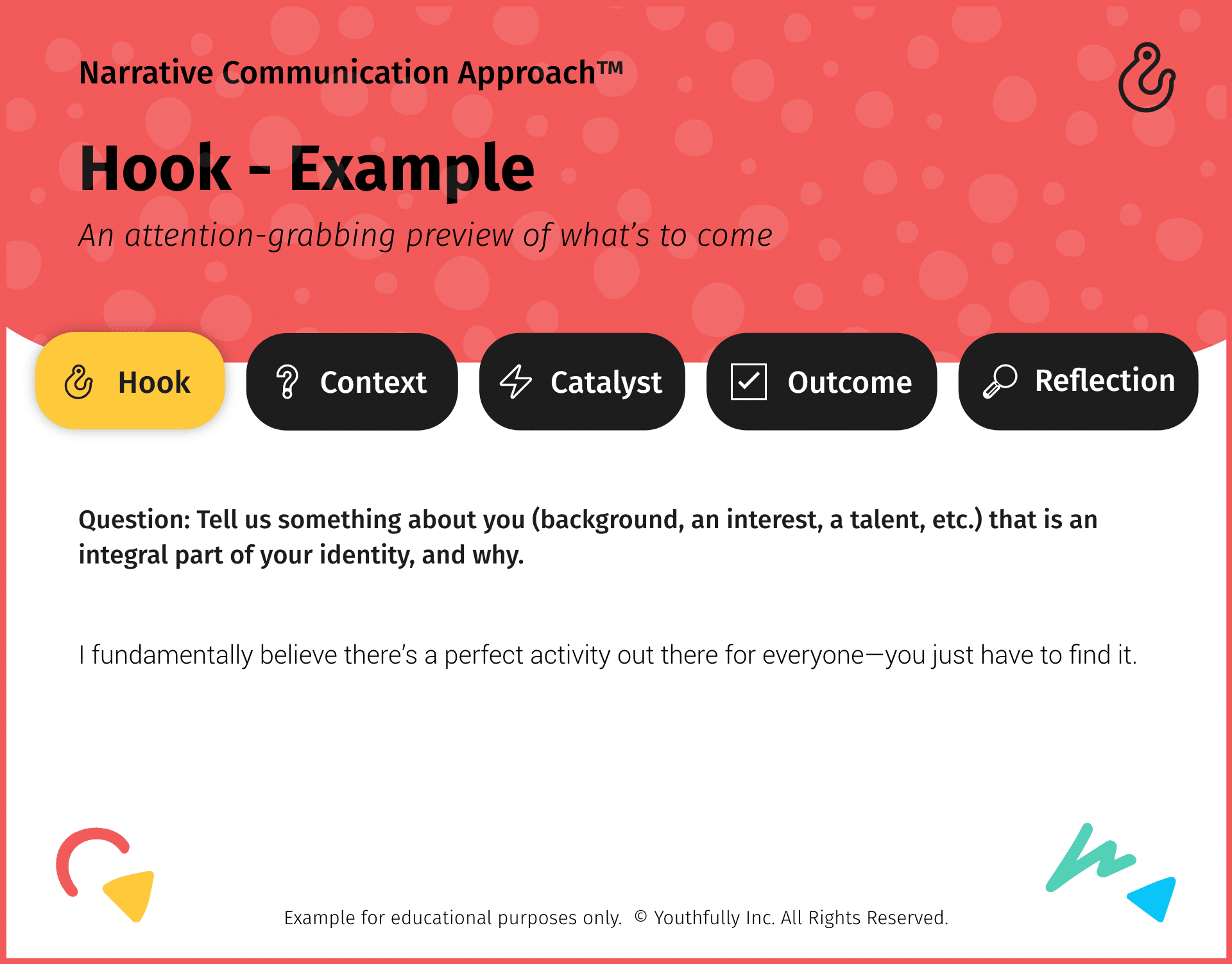
Notice how the student isn’t giving away too much, but you feel intrigued and want to learn more? That feeling is exactly why the Hook is so effective.
Improve Your Communication Skills – Context
The Context in your essay will:
- Provide background and “paint the picture” of your story
- Answer the important questions: Who, What, When, Where, and Why?
- Provide key details, like where you were, which characters were involved, how old you were, and what activity you were involved in
- Use personal insight, or information that helps your reader get a sense of who you are, what’s important to you, and how your experiences have shaped the person you are today
In our The Fast and The Furious example, we’re introduced to LAPD officer, Brian O’Conner (Paul Walker), who is investigating Dominic Toretto (Vin Diesel) and his friends while undercover at a street race. We get a background of the characters, what they are interested in, where they are located, and what they value.

“Bad” movies typically rush through Context, making you confused about what’s going on in the rest of the movie!
Communication Skills Examples – Context
Here is an example of Context from the Business/Arts application to Queen’s Commerce that we referred to earlier.
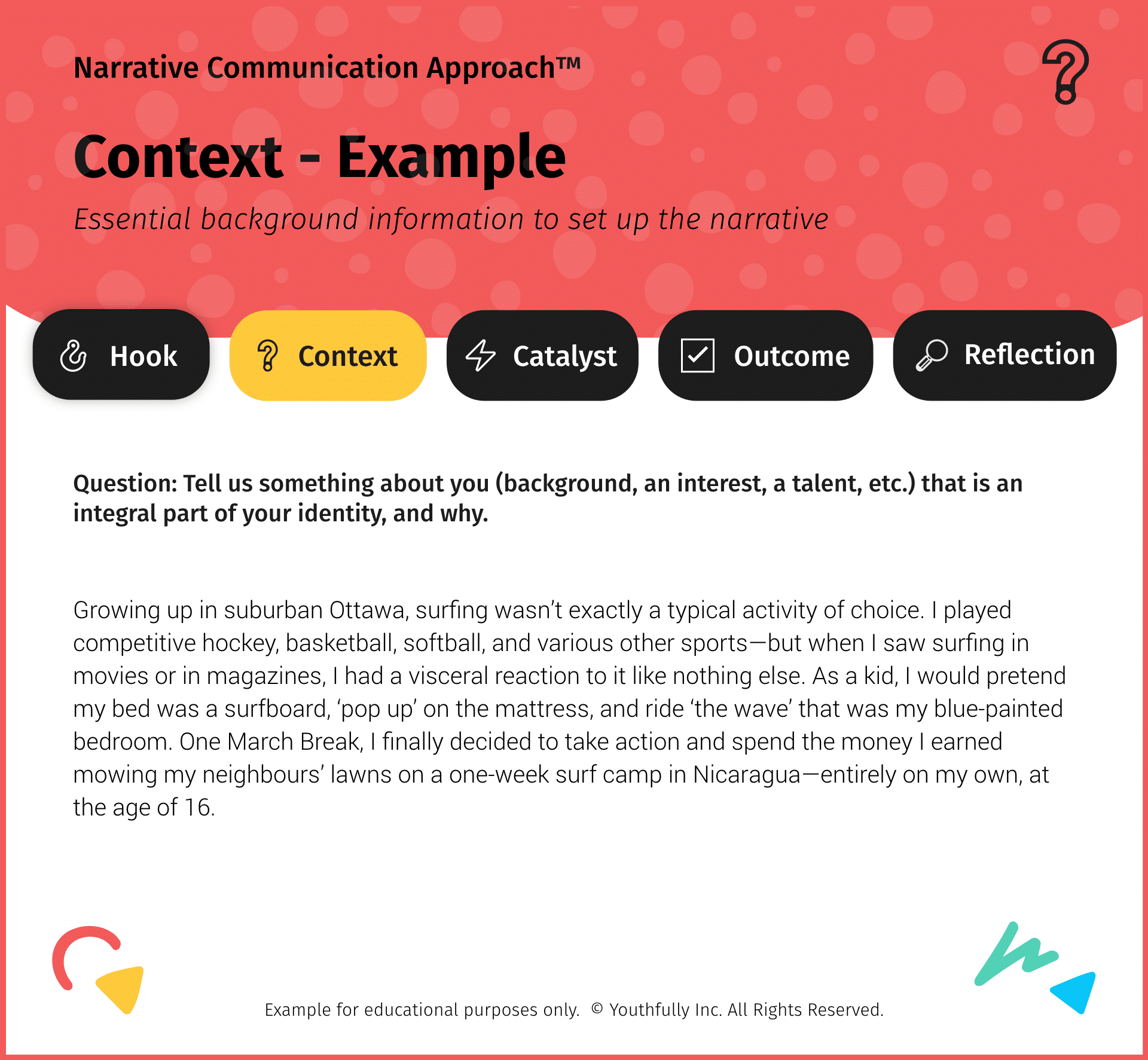
Notice the emotional connection he is making right from the beginning with the details he gives about his background. We can immediately see his sense of excitement (“I had a visceral reaction to it like nothing else”) and determination (“I finally decided to take action”). This makes us invested in him and creates hope that he will get to live his childhood dream.
COACH’S TIP: While many of us deal with difficult experiences like depression, anxiety, and learning disabilities, we’ve seen an unfortunate trend in the past where the students who chose to share this in their essays were not successful. This has been the case for top-tier, highly competitive programs.
We believe admissions committees may have negative reactions to these stories because they might doubt a student’s ability to transition successfully at university. If you still feel compelled to share these experiences, speak with your coach about how to do so in a manner that evokes positive emotions and trust for the reader.
Improve Your Communication Skills – Catalyst
The Catalyst section in your essay will:
- Describe a shift or change from what was normal (usually through a specific event or a gradual change over time)
- Discuss a conflict, struggle, adversity, or obstacle that you were faced with during your experience that helped you develop as a person, student, and young professional
- Show your reader how you deal with change, opportunity, or adversity and use it as an opportunity to grow
Every story NEEDS a Catalyst section. This is an opportunity for you to display your ability to face adversity and capitalize on opportunities that further yourself as a person.
COACH’S TIP: Try to limit yourself to two Catalysts at most. Less is more.
In our The Fast and the Furious example, Brian discovers that Dominic and his crew are in fact the hijackers he has been looking for, and that the crew is planning a big heist that night. Dom’s sister Mia finds out that Brian is a cop.
The crew attacks another truck and some members are badly hurt and they barely escape. As an audience, it seems like things go from bad to worse. In other words, the ‘normal’ is completely changing.

Communication Skills Examples – Catalyst
Here is an example of Catalyst from a Business/Arts application to Queen’s Commerce from the question that we mentioned earlier.
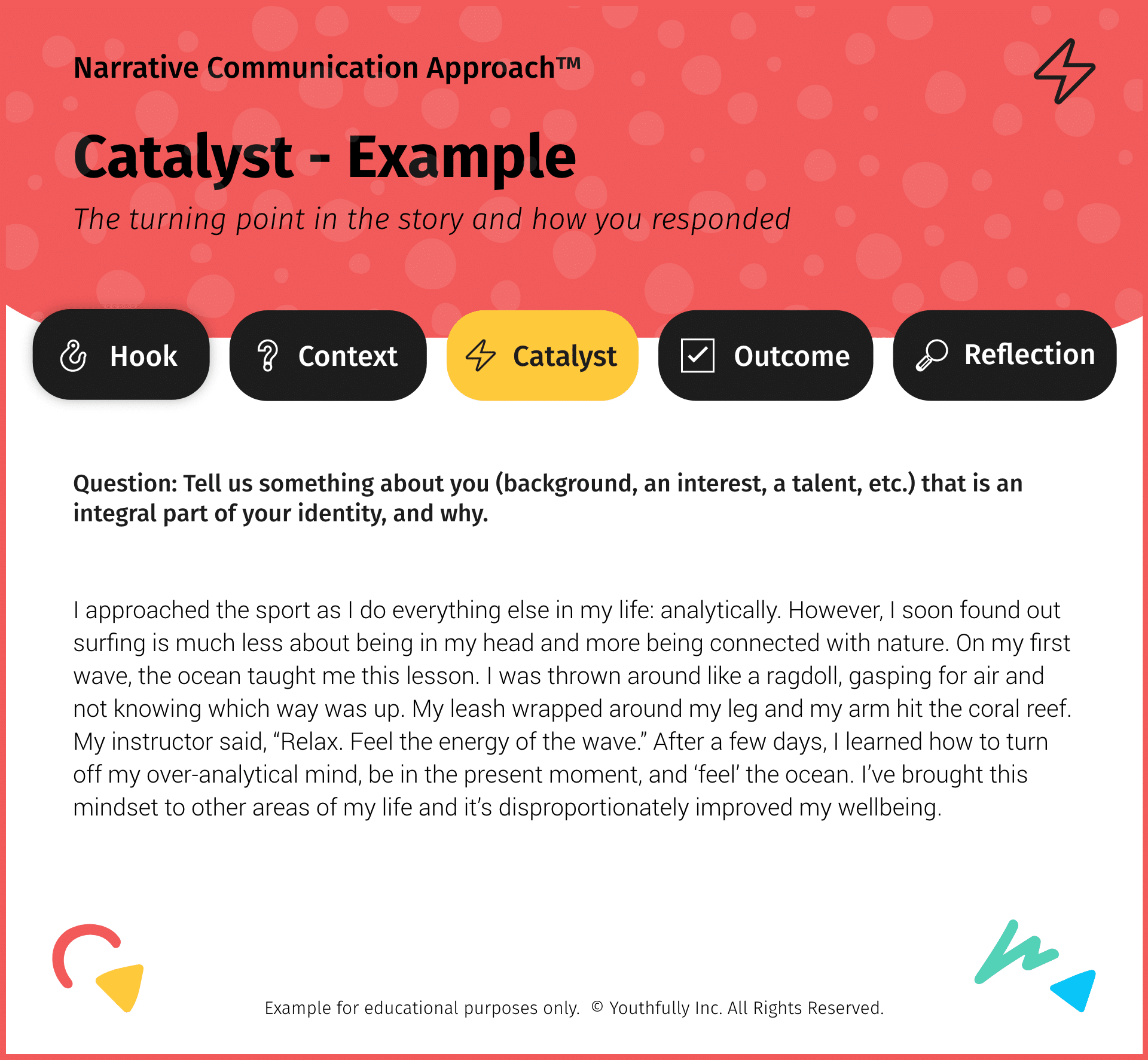
Here we can see a description of the student’s transformation over time. At first, he over analyzes things too much, which hurts his technique. The Catalyst is when the wave drags him around and he hits a coral reef during his first attempt. This is the turning point of his journey. Afterwards, he uses this opportunity as a chance to learn and grow as a person.
Finally, it is also important to connect this your Catalyst section to other paragraphs in your essay: did it play into the emotions you described in the Context section? Why did it inspire you to act?
In our surfing example above, we can see the passion for surfing that this student introduced in the Context section (“As a kid, I would pretend that my bed was a surfboard”) is what inspires him to overcome his setback in the Catalyst section. This shows his readers his determination and commitment, which is something that admission committees want to see in future students of their program.
Improve Your Communication Skills – Outcome
The Outcome section in your essay will:
- Describe the end result and impact that your experience had on yourself/others
- Sum up the result of everything you’ve done in this activity or experience
- Provide a resolution to the challenges you faced in the Catalyst section
In our The Fast and the Furious example, the Outcome happens when Brian gives Dominic his car keys and tells him to flee from the approaching police, as sirens are heard in the background. This tells the audience that Brian is now part of the crew and is giving up his job as a cop to protect his new ‘family’. Then, after the credits, we see Dominic driving in Mexico.

When writing this section in your essay, you can focus on both intrinsic and extrinsic outcomes.
Intrinsic outcomes: Skills and character traits that you developed from the experience (e.g. problem-solving, organization, and leadership). For example, If you established a Spirit Club at school because your school lacked a collegial culture, highlight how your collaborating abilities progressed when you enlisted more members of the student body.
COACH’S TIP: Some schools, such as Western Ivey, look for specific character traits. Read the school’s values page on their website to learn more about the traits they seek, and speak to your coach about which ones align to you. Use this section as an opportunity to show the application committee that you would be a great fit for the program and that you have the personal and academic traits it takes to succeed.
Extrinsic outcomes: Tangible results best communicated through measurable, quantitative metrics (e.g. raising a certain amount of money, recruiting a certain number of club members, etc.).
Communication Skills Examples – Outcome
Here is an example of an Outcome section from a Business/Arts application to Queen’s Commerce with the same question that we referenced earlier.
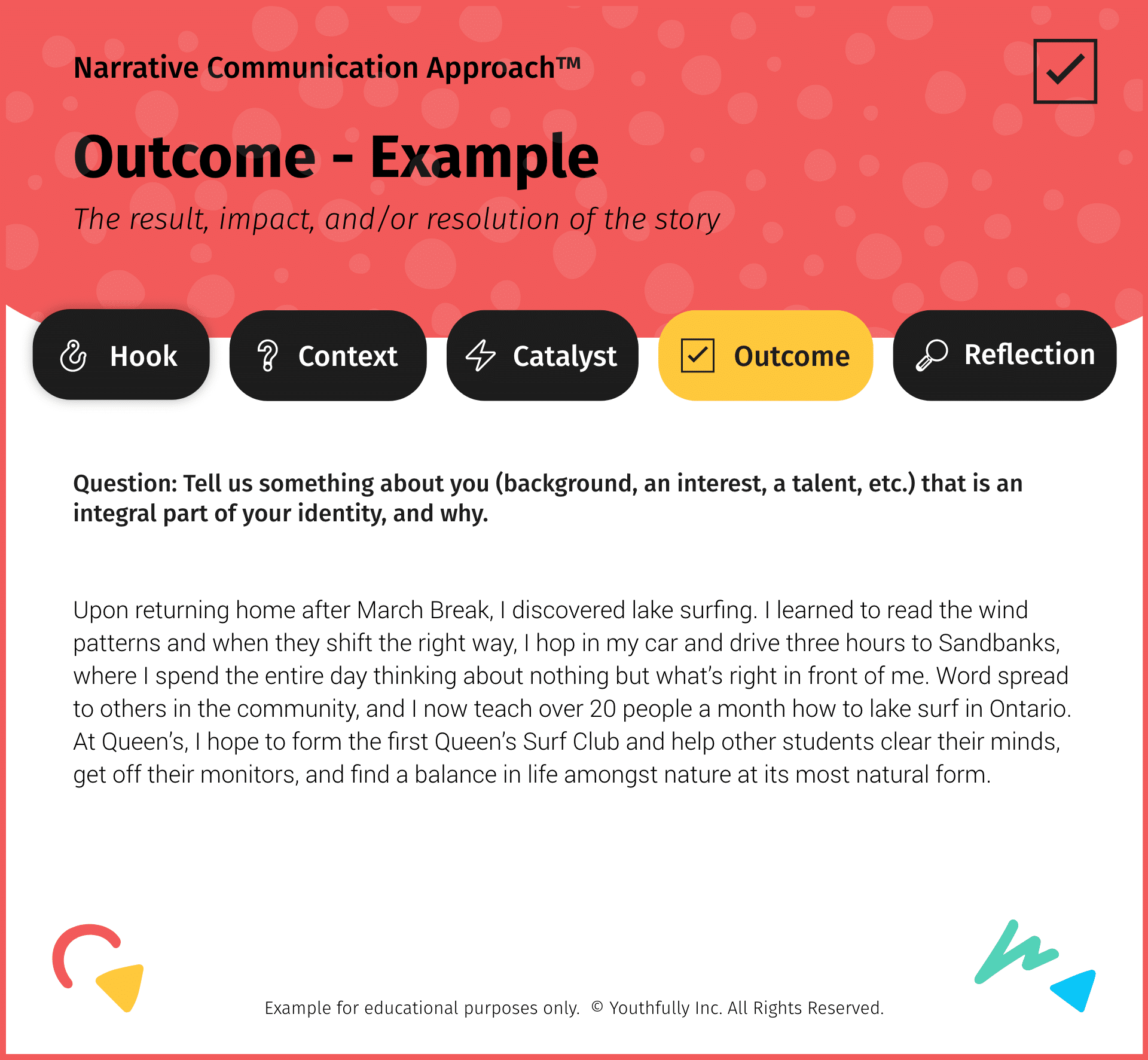
After he expresses conflicts that arose in the Catalyst section, he then demonstrates a positive result from his challenges. We can also see how he is tailoring his experience specifically to Queen’s by showcasing his leadership/entrepreneurial skills, while also offering to contribute something unique to Queen’s as a whole.
Improve Your Communication Skills – Reflection
The Reflection section in your essay will:
- Discuss the moral of your story
- Detail what you’ve learned and how you’ll use these lessons going forward
- Show the continued impact of your experiences as well as your commitment to them
COACH’S TIP: Some schools explicitly ask you to answer “what have you learned?” in the essay question and others won’t. Even if you aren’t explicitly asked, your essay should almost ALWAYS have a Reflection section.
There are two key components to your Reflection section:
1. Learning
State that what you’ve learned isn’t universally known by the reader. The less your learning is known to the reader, the more impressed they will be with that learning.
For example, saying something like, “I learned that it’s important to work hard,” is too obvious and doesn’t show that you’ve really taken the time to reflect deeply on your experience.
Instead, a better learning could be that “Eureka” moments almost always come when people are in the shower or out for a run. However, these subconscious moments are limited if we are constantly distracted by our computers or phones.”
To ‘level-up’ your learning/reflection try reading, listening to podcasts, and keeping up on the latest articles by deep thinkers like Gary Vee, Josh Waitskin, Chamath Palihapitiya, Tim Ferriss, or Lewis Howes.
Your coach will also ask you questions that will prompt this kind of thinking to occur naturally and for deeper reflections to occur.
2. Insight
Go a step further and discuss why your learning is important and how it can be applied to your life today, your experience as a future student, or in your career. Take the time to answer the question “so what?”. Articulate a clear and specific action, and the lessons you’ve learned from it.
In our The Fast and the Furious example, the moral of the story (or the Reflection) is that family and loyalty is everything. We see the characters come up against serious conflict, but in the end it is their willingness to stick together and their loyalty to one another that really stands out.
Brian didn’t feel that sense of family as a member of the police force, but the way Dom and his group embraced Bryan made him want to be part of the family—despite alienating his career and moral compass.

Communication Skills Examples – Reflection
Here is an example of Reflection from a Business/Arts application to Queen’s Commerce from the reflection section question we mentioned earlier.
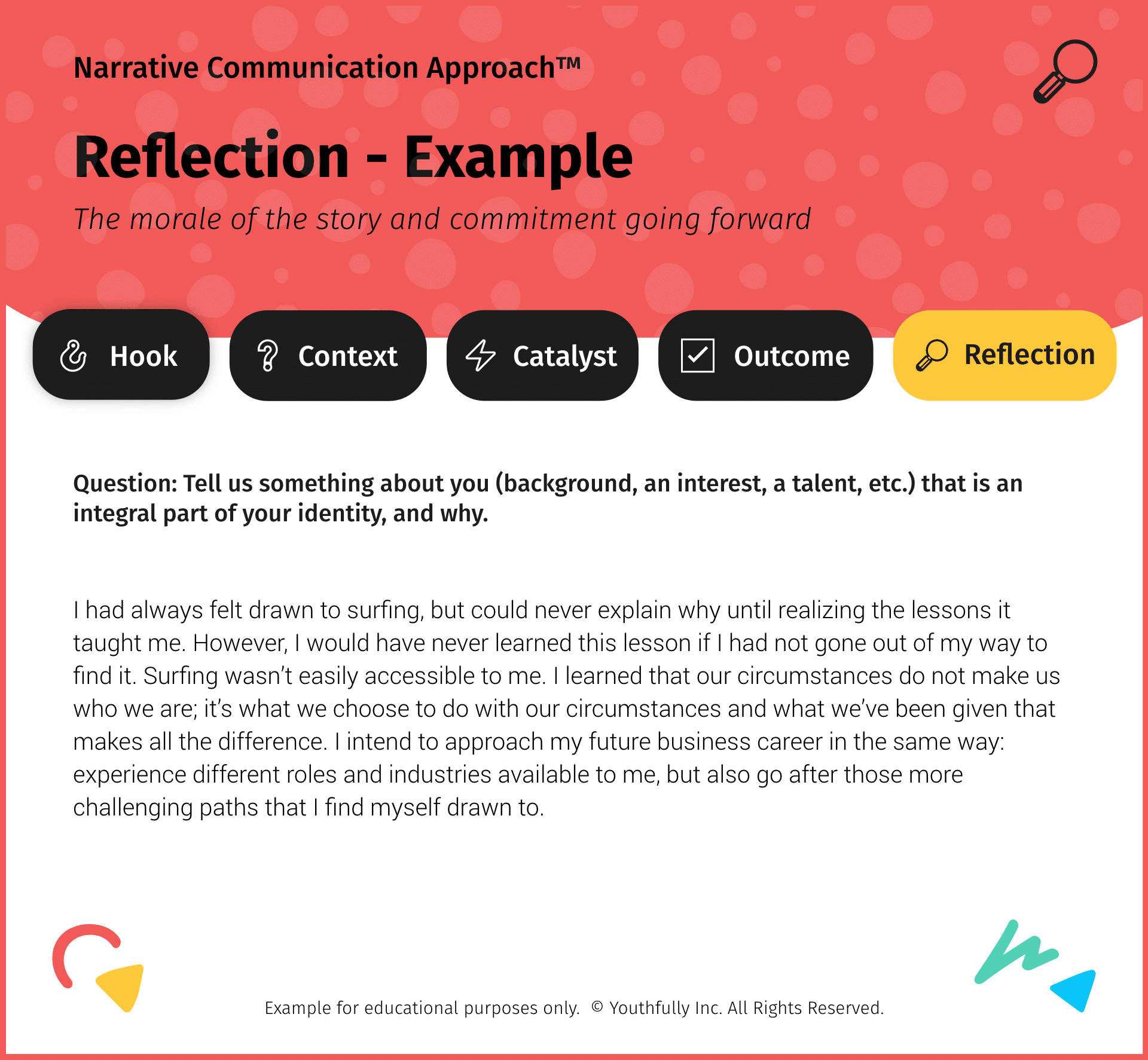
In this example, we see that this student took what he learned about facing challenges and trying something new even though it was difficult and inconvenient. He applies this learning to his future career goals so that he can become a well-rounded leader and better discover where his career goals lie.
Communication Skills Examples – Putting It All Together
Now that we have gone through the five components of creating a concise and emotional essay, let’s see what the finished product looks like in the end.
Here’s the Queen’s Commerce example, with all the elements of the Narrative Communication Approach™ we discussed above included.
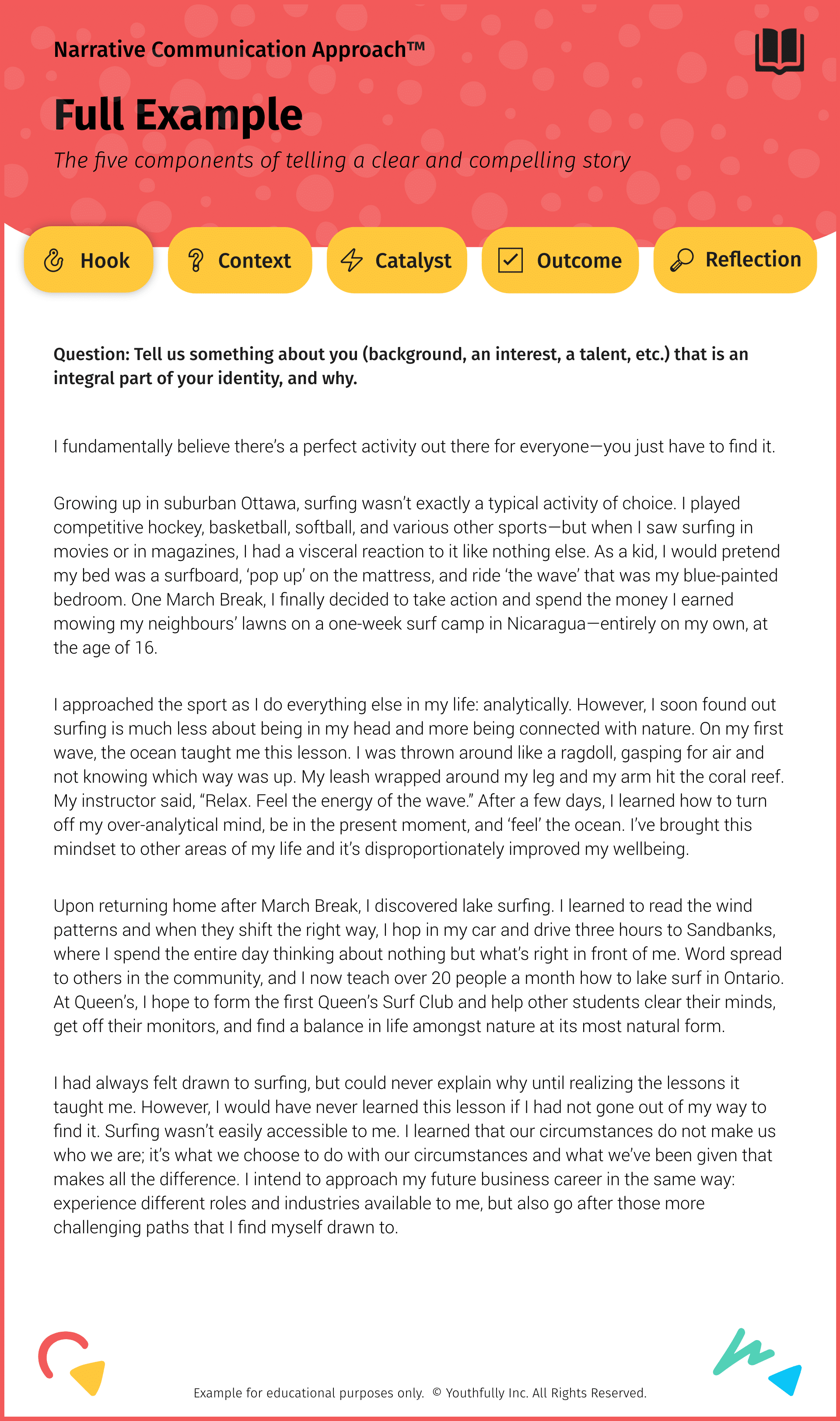
It’s amazing, right?!
Keep reading below to learn tips and tricks for editing and perfecting your essay once you’ve identified a topic and have written it.
If you want to discover how you can relate these five components to your unique experience in your application, connect with a coach today!
School doesn’t teach real world skills. We do.
get a youth coach™
The Process: How to Showcase Your Communication Skills Using the Narrative Approach.
Now that you have learned more about how you can communicate your ideas using the Narrative Communication Approach™, it’s time to talk about the actual process of writing your essay.
In this section, we will teach you about the process of choosing your topic, building and writing your story, and revising it so it’s flawless.
Step 1: Find The Perfect Topic
Identify a Theme
Before writing your essay, you must first identify the overarching theme or narrative that you want to discuss.
Regardless of the question, you first need to decide what the takeaway message is.
If the reader had to walk away with one message, what would that be? This is your takeaway message.
COACH’S TIP: Don’t make it too complicated. Think about how the reader would explain your essay in one sentence. If it would take a lot of explaining, then you know your idea is too elaborate.
In our Queen’s Commerce surfing example above, the question is: Tell us something about you (background, an interest, a talent, etc.) that is an integral part of your identity, and why.
This is a somewhat general question, but you can make it specific by relating it to a unique experience. The student uses the theme/interest (surfing) to discuss his background (growing up in suburban Ottawa, playing sports in high school, having a part-time job, etc.) and show how he fundamentally changed as a person because of this experience.
Tie Your Theme to an Experience
To make your theme stand out and give you the opportunity to provide some real life examples.
You can choose to focus on one of your extracurriculars (like a club you joined, a sports team you played on, or your time as a volunteer) or life experiences (like moving to Canada or work you’ve done in your community).
It’s also important to use this experience to help you communicate some essential points about yourself, like your passion for business or your critical thinking skills.
Your coach can help you find a topic and discover ways that you can relate your experiences to this theme.
If you have completed your Student Identity Blueprint™, it will be easy for you and your coach to choose a topic. If you haven’t yet, connect with a coach to get started.
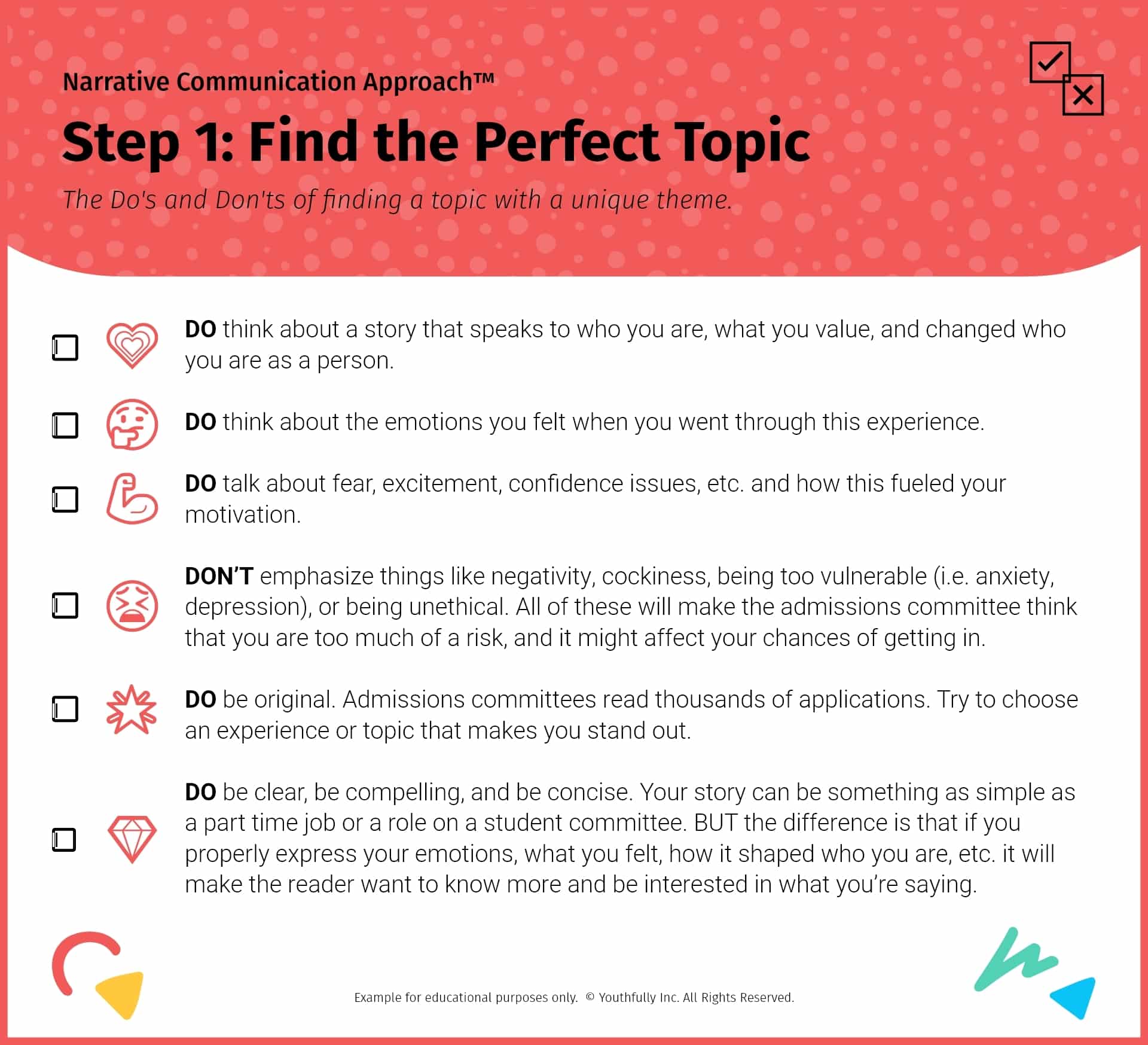
Step 2: Set Up The Structure
Structure is key because it shows that you have really thought about your topic and you can communicate key messages effectively.
Using this structure doesn’t mean your essay will look like other applicants’ essays.. You’re simply following the process about how to tell a story. If you don’t want to tell a story, then do not use this structure.
When organizing your essay, your coach will work with you to co-create a suggested template that breaks down each section and tells you what to focus on.
Many of these suggested templates are already built and available on our resources page.
Make sure your structure follows the storytelling process mentioned above. In the template, you will see these sections: Hook, Context, Catalyst, Outcome, and Reflection.
The template for our Queen’s Commerce surfing example looks like this:
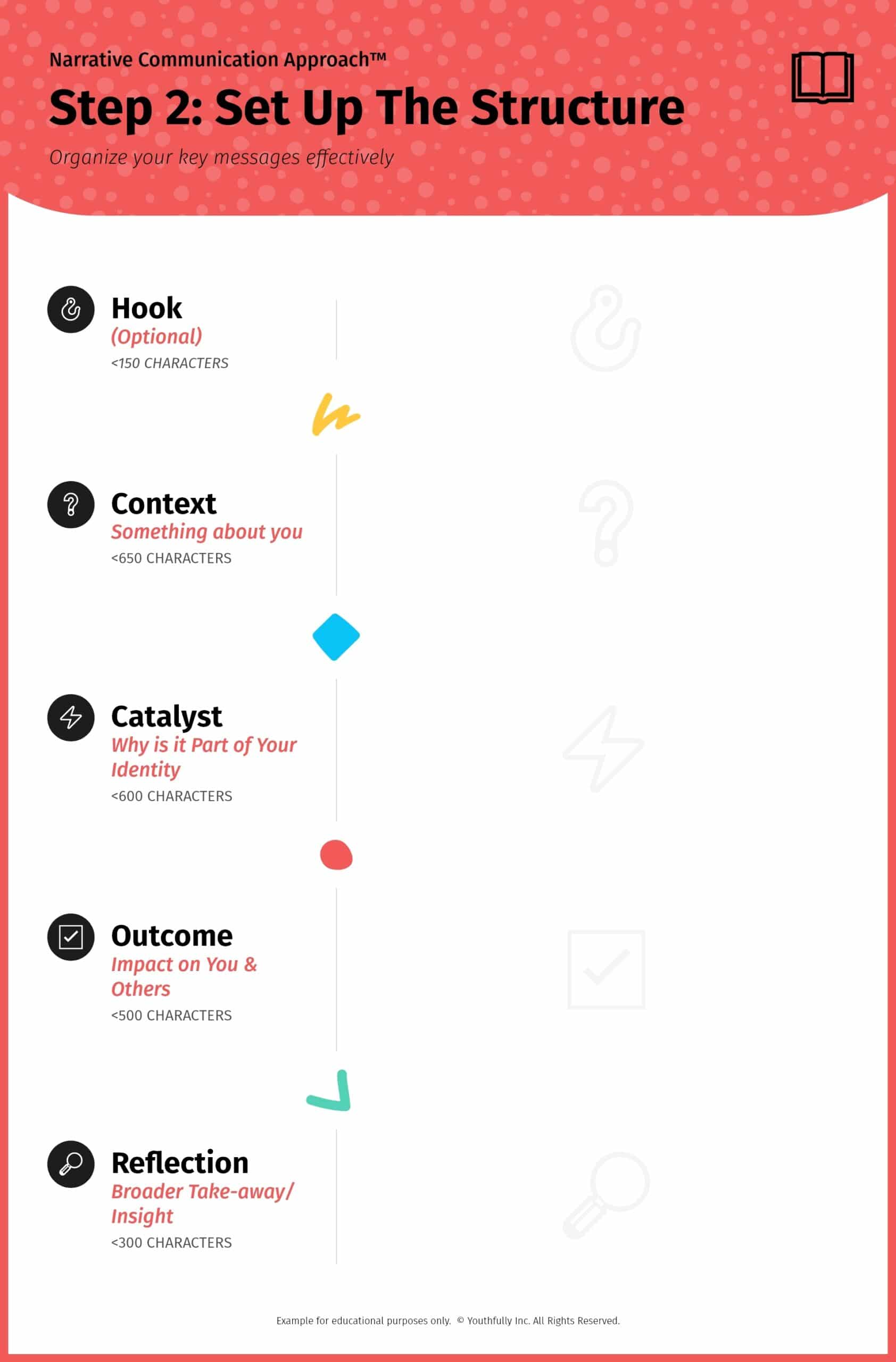
REMEMBER: most programs have a character limit (which includes spaces) for their essays that you MUST follow. Keep reading to learn more character count tips.
COACH’S TIP: When setting up the structure, always keep in mind what the program is looking for and save the majority of character count for that section. For example, Queen’s Commerce likes to see you focus on the Reflection section while Ivey likes to see a focus on the Outcome/Impact sections.
Step 3: Get The Flow
Under each section in the template, create rough notes that discuss the key things you want to include. For each bullet point, try to have one key message per sentence to keep your theme clear and focused.
Don’t worry about character count or polished writing at this point, just get something down.
Your coach can help you create these bullet points during your coaching calls. By simply discussing general points together, you’ll have created the first draft of your essay. It’s that easy!
In our Queen’s Commerce surfing example, the rough bullet points in the template looks like this:
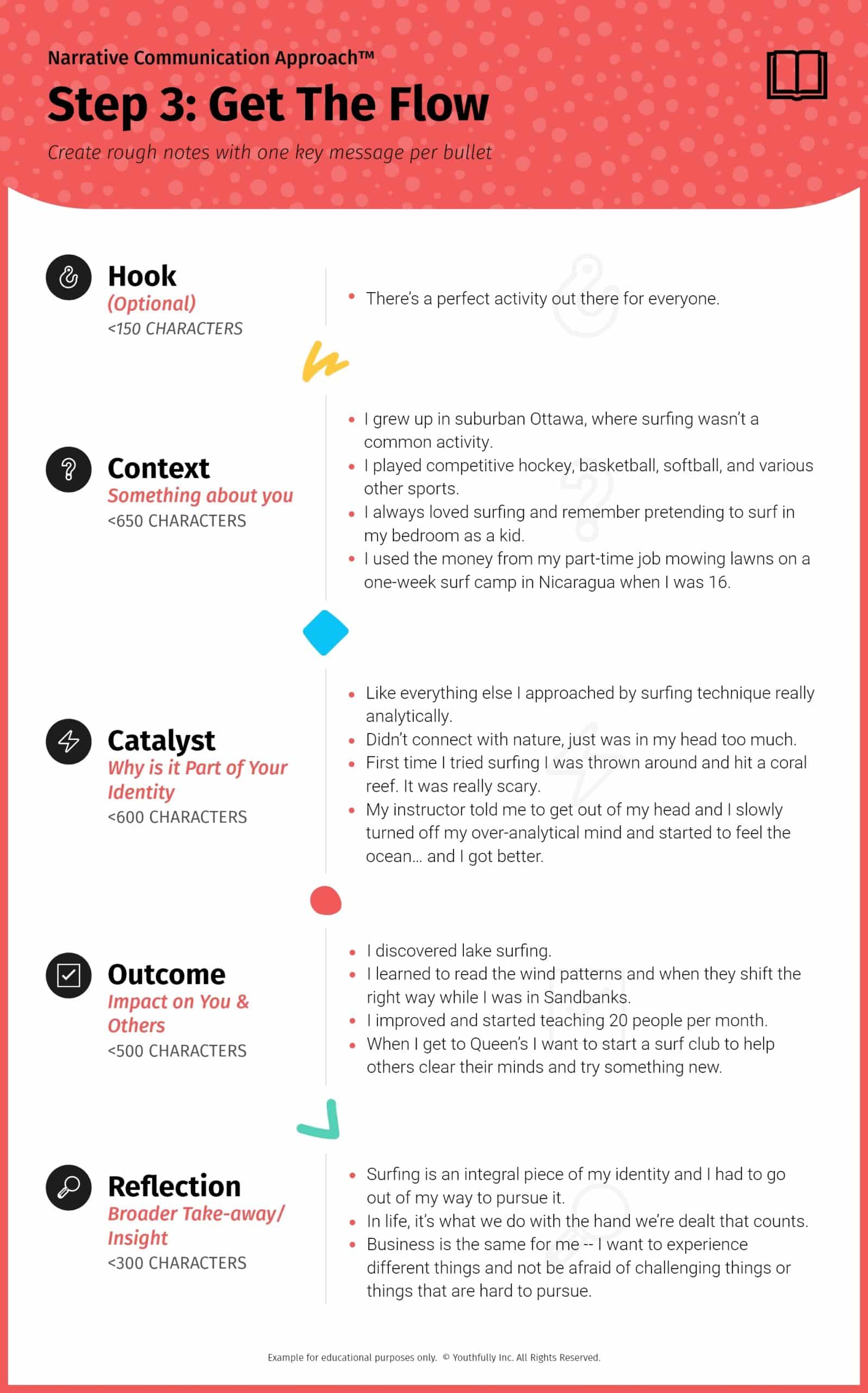
Your coach can help you create these bullet points and come up with a summary of the points you want to include. In our coaching calls, your coach will ask you to tell them what you want to say in each section, and by simply discussing it together you will have created the first draft of your essay.
If you haven’t already, connect with a coach to get started!
Step 4: Creating A Finished Version and Revise
Fine-tune the points you’ve made to create complete sentences.
Make sure that each point is clear and compelling, and take out some of the sentences/sections that don’t add value to the main point or are repetitive.
In this step, you’ll probably need to move some sentences around. That’s okay! Do this to make sure each point is connected and that each section flows into the next one.
Remove the bullet points, and voilà — your essay is done!
In our Queen’s Commerce surfing example, the finished template looks like this:
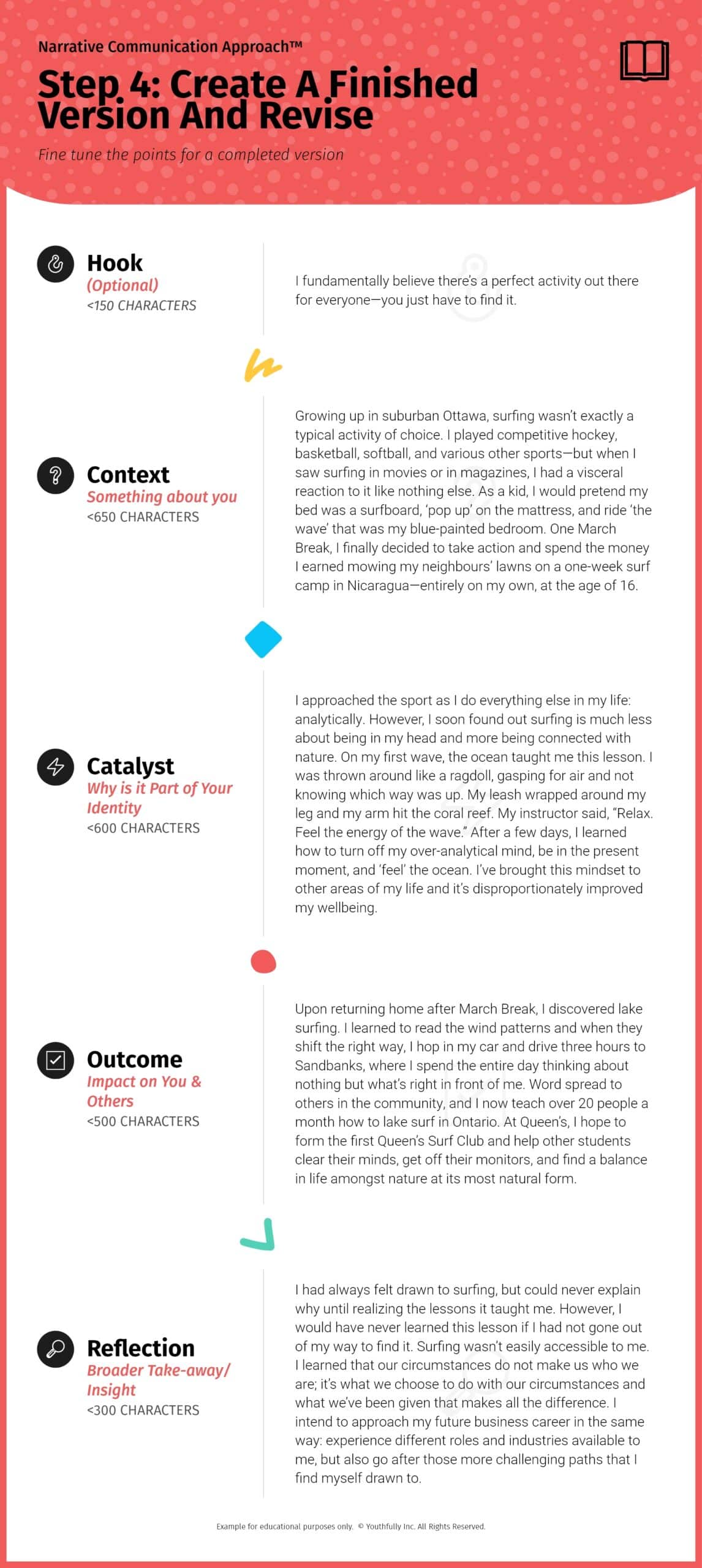
Step 5: Final Proofing and Polishing
Making sure that your essay is completely error-free is really important.
Perfect the grammar and make sure that all your points and themes are clear and concise. Then, check the character count and cut some things if you need to.
Next, give your essay to one or two people who you trust to read it and provide feedback. It will also help to ask someone who is already in the field you’re applying to to read it to make sure that it makes sense to them.
COACH’S TIP: Don’t ask too many people to read your essay. This leaves you open to conflicting views or suggestions that can stress you out or confuse you.
Once you have finished proofing your essay, walk away from it for a day or two. Stepping away can help you see things that you might have missed.
REMEMBER: Once your essay is done, be confident in the work you’ve written! We see so many students get really stressed out about what they should have changed. If you follow these steps, be happy with your work and confident that you did the best you could. Stressing and being anxious won’t get you anywhere!
You Might Also Like
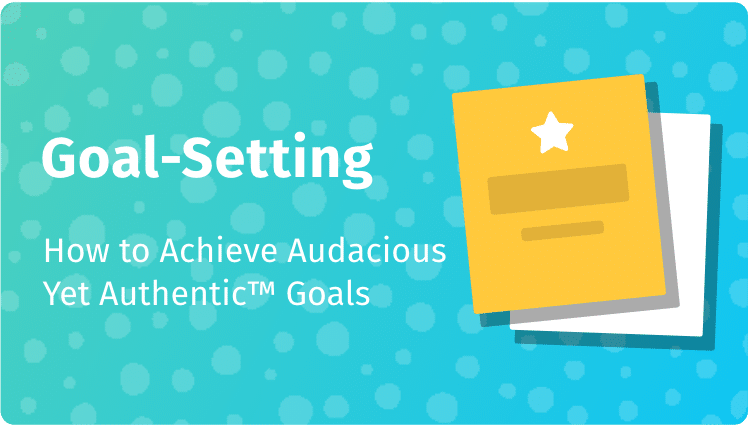
Skills Training
Goal Setting for Students: How to Achieve the Goals You Want
The world’s leading organizations, top executives, and Olympic athletes all set goals. You’re the GOAT in your own life, so… Read more
You’ve Got a Dedicated Coach in Your Corner
For over a decade, we have successfully helped thousands of students achieve more than they ever thought possible.
Our 1-on-1 Youth Coaching fills that gap that most high schools miss. We can help you build self-awareness through probing questions and assessments, set bigger goals to elevate your extracurriculars and future career plans, and improve skills that matter on supplementary applications, such as interviewing, communication, critical thinking, and creativity.
We use a coaching methodology, called ‘full student’ development, that’s been proven to increase your chances of admission to top-tier universities and obtaining competitive jobs/internships.
So, what are you waiting for? Fulfill your post-secondary potential with the mentorship and coaching you’ve always wanted! 🙂
IMPORTANT: Want to share information and/or images from this resource on your own website, blog, article, etc.? Please ensure you reference content of any kind published by Youthfully Inc., in whole or in part, using the following statement: (1) Our Organization (Youthfully Inc.); (2) The title of our content/resource; and (3) the URL to our webpage where the content was originally posted. For example: “Sourced from: Youthfully Inc., ‘Narrative Communication: How to Tell Memorable Stories People Remember’, https://youthfully.com/narrative-communication-skills/.”
Not doing so is an infringement of copyright and is illegal. We spend significant time developing resources for students, so please take a few seconds to ensure they are referenced properly.

